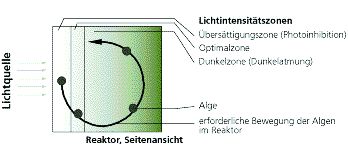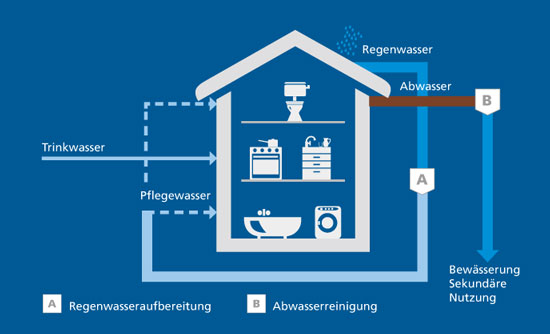It is important to keep pollutants out of rainwater while it is being collected. For this reason, a filter with a diameter of 0.6 mm was fitted to the inlet pipe in order to clean rainwater before it even enters the cisterns. Another effective measure is a valve at the inlet of the cisterns which closes automatically for a certain period of time once it has started to rain. This keeps the first flush which is heavily contaminated from overflowed upper surfaces from reaching the cisterns. Most of the chemical parameters for raw water then already show drinking water quality.
DEUS 21: Rainwater recycling in demonstration projects in Knittlingen
Pollutants in rainwater
In spite of these protective measures, traces of some pesticides were still detected in the cisterns. These probably come from the roof-insulation of surrounding houses. Concentrations of sodium and chloride were higher especially in winter, probably due to the salt sprayed on icy roads. During the other seasons of the year, the concentration of salt in the cisterns was low and cistern water was softer than drinking water. Rainwater flowing over surfaces such as roofs and roads in the newly developed area brings a multitude of microorganisms to the cisterns. Inorganic solids are also found from construction work on the site as well as organic substances from the surrounding vegetation.
Optimum light supply

Microalgae can use light efficiently only if they are subjected to strong light for a short time, followed by a dark period lasting about ten times as long. With the FPA reactor, the liquid in the reactor is moved by air bubbles. Static mixers create vortices in the liquid flow, in which the algal cells are transported back and forth between the illuminated surface layer and the larger dark zone. With this airlift loop principle it is also possible to supply sufficient light to algae cultures with high cell density.
The system is also suitable for central European latitudes where the overall light intensity is lower.
Multistage treatment process
Cistern water is treated to drinking water quality in a multistage treatment process. The first step is to eliminate particles from the cistern water with a filter whose pores are 1 µm in diameter. Then, organic components are oxidized by adding ozone with special focus on eliminating pesticides. The water subsequently flows through an active carbon filter where oxidation products can be adsorbed and degraded biologically. In this step, inorganic components should also be bound from the rainwater by adsorption. In the next phase, the water passes through an ultra filter which catches the finest particles and any microorganisms still remaining in the water. The final step is to irradiate the treated water with UV light to ensure that it is free of germs.
Our plans to reduce the concentration of salt in rainwater have more to do with good organization than with complicated chemical technologies. It is better to reduce the amount of salt by using less to free roads from ice and by closing off the cisterns during adverse weather conditions.
Treated water can then be distributed to the homes on the site from a reservoir. The water flows through a circular set of pipes around the development area and back to the reservoir to stop it from stagnating and becoming re-contaminated. Another UV lamp in the return flow kills any germs which might have grown in the pipes.
Funding
We would like to thank the German Federal Ministry of Education and Research (BMBF) for funding the project "Decentralized Urban Infrastructure Systems DEUS 21", promotional reference 02WD0850.

 Fraunhofer Institute for Interfacial Engineering and Biotechnology IGB
Fraunhofer Institute for Interfacial Engineering and Biotechnology IGB